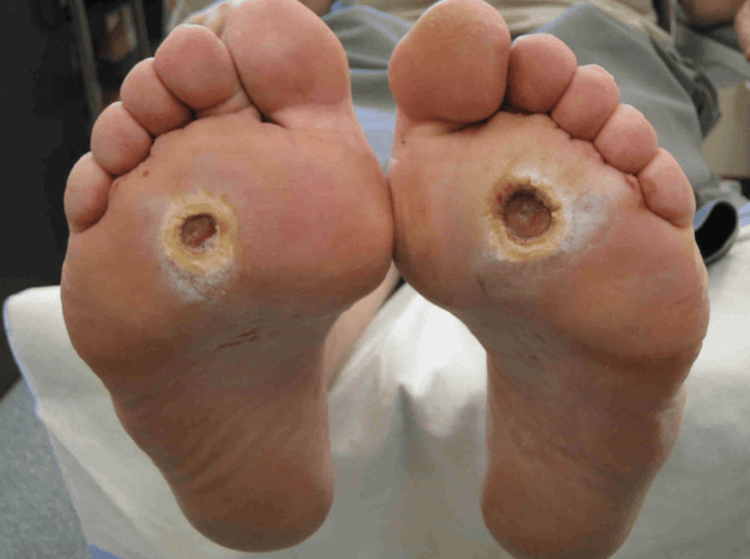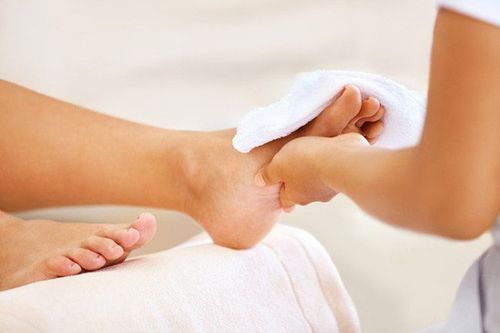This is an automatically translated article.
The article is professionally consulted by Master, Doctor Nguyen Thi Ngoc - General Internal Medicine - Endocrinology - Department of Examination & Internal Medicine - Vinmec Central Park International General Hospital.Complications of diabetes can be foot ulcers, amputation. Diabetic patients with foot ulcers have a 10-15 times higher risk of amputation than the general population. In particular, when superinfected, ulcerative lesions increase the risk of amputation in diabetic patients. However, most of these injuries are preventable if the patient knows how to take care of diabetic ulcer complications.
1. Causes of diabetic foot ulcer complications
Causes of foot ulcers in diabetics include:Peripheral nerve damage: can occur in any person with diabetes, this diabetic complication reduces the ability to feel perceive sensations in the feet as pain, heat, or cold; The patient cannot feel his foot has been damaged. When the foot is swollen or the infection is severe, it can be difficult to treat. Diabetic foot ulcers are common on the ends of the metatarsals, big toes, heels, or calluses on the feet and between the toes. Damage to blood vessels: People with diabetes are often prone to atherosclerosis, narrow or blocked blood vessels that reduce blood flow to the feet. This takes a long time for diabetic foot ulcers to heal. Infections: People with diabetes are more susceptible to infections than the general population because high blood sugar allows bacteria to grow. Poor blood flow to the feet makes foot injuries take longer to heal. Just a small wound can cause infection and diabetic foot ulcers. If infection is combined with anemia, the risk of amputation is very high. Calluses are often the first sign that can lead to diabetic foot ulcers. If the callus is red and painful, or the skin on the foot changes color or has a foul-smelling discharge, it is usually a sign that you may have diabetes.

Hình ảnh loét bàn chân tiểu đường
2. Taking care of diabetic feet
2.1. Taking antibiotics Taking blood sugar-lowering medications Your doctor may prescribe oral antibiotics or topical creams containing antibiotics to kill bacteria and help the wound heal faster. 2.2. Check your feet daily Self-exam from top to bottom. You can ask a loved one to help you with diabetic foot ulcers if you can't see them clearly. According to the American College of Foot and Ankle Surgeons, routine foot exams performed by foot and ankle surgeons can reduce the risk of amputation by 45-85%. Choose a fixed time of day to make it easy to remember, choose a place with good lighting, use a mirror to easily observe diabetic foot ulcers. You should also check between the toes, between the nails for scratches, calluses, blisters... Check the skin for dryness, redness, heat or tension when touching any area of the foot. Check the growth of the toenail is abnormal, the nail is inverted. 2.3. Clean feet Use mild soap and warm water (about 37 degrees Celsius is best) to wash your feet every day, paying attention to dry thoroughly, gently, do not rub vigorously. Wash and disinfect the wound with physiological saline or povidone iodide at least 2 times a day, paying attention to dry, gently, without rubbing. Limit washing the wound with hydrogen peroxide unless prescribed by a doctor. After cleaning the wound, use a sterile cotton gauze containing calcium alginate or silver sulphadiazine to cover the wound, but do not bandage it too tightly. If the skin is too dry, you can use moisturizing creams, especially the heel area, do not apply between the feet. If diabetic foot ulcers are detected with signs of bleeding, infection, pus or necrotic black spots, the patient needs to be re-examined to be prescribed more appropriate drugs. Absolutely do not arbitrarily cut, filter the black spots necrotic if not instructed by the doctor before.

Rửa chân sạch sẽ và nhẹ nhàng
2.4. Protect your feet with shoes and socks Always wear footwear to avoid stepping on broken bottles and sharp objects that the patient cannot see. Flip-flops should not be worn as this can cause ulcers between the thumb and second toe. Always wear socks to keep warm and protect your feet, socks should be soft and woven with natural fibers, without seams. Change into clean and dry socks every day. Avoid wearing shoes that are too tight because they can cause blisters on the skin; Always wear socks when you need to wear shoes to avoid blistering your feet. It is necessary to check shoes before wearing to make sure that there are no objects in shoes such as dust, insects... that can damage your feet because you may not be able to feel small objects in the shoes. wet with rain and snow. Do not go barefoot even at home How to choose shoes:
Choose shoes that must be closed toe and heel. Choose shoes with soft leather, the inside is not rough. Make sure the shoe is at least 1.3cm wider than the foot, try on the shoes in the afternoon. Be careful with the temperature of 2.5. Easier circulation of blood vessels Elevate your legs with a chair while sitting. Do not sit cross-legged for too long. Don't wear tights or knots around your ankles. Move your toes and ankles for 5 minutes 2-3 times a day. Exercise your feet daily to increase blood circulation in the feet such as walking, cycling, ...

Không ngồi bắt chéo chân trong thời gian quá lâu
2.6. Prevent foot burns Check the water temperature before bathing, wash using a thermometer or the back of your hand or elbow. The water temperature is neither too hot nor too cold. Around 40 degrees Celsius is best. Do not warm your feet by methods such as heating with a brazier, heating with heated bricks, steaming your feet with hot water, soaking your feet in hot water, burning wormwood leaves, turning off electric blankets... because it can cause burns. diabetic foot ulcers. Apply sunscreen to bare skin when going out in the sun. 2.7. Go to a medical facility when experiencing diabetes complications When experiencing diabetic complications such as skin lesions, or calluses on the feet... should not be treated at home, but must be examined at a medical facility for prompt treatment and care instructions to avoid further complications.
At Vinmec International General Hospital, we always deploy a screening package for diabetes and dyslipidemia to help detect pre-diabetes early, accurately classify diabetes type, and develop a nutritional regimen. Monitor and minimize the risks and complications caused by diabetes.
Please dial HOTLINE for more information or register for an appointment HERE. Download MyVinmec app to make appointments faster and to manage your bookings easily.
SEE ALSO :
Foot disease in diabetics Numbness of hands and feet: Beware of diabetic complications Good and bad food for diabetics













